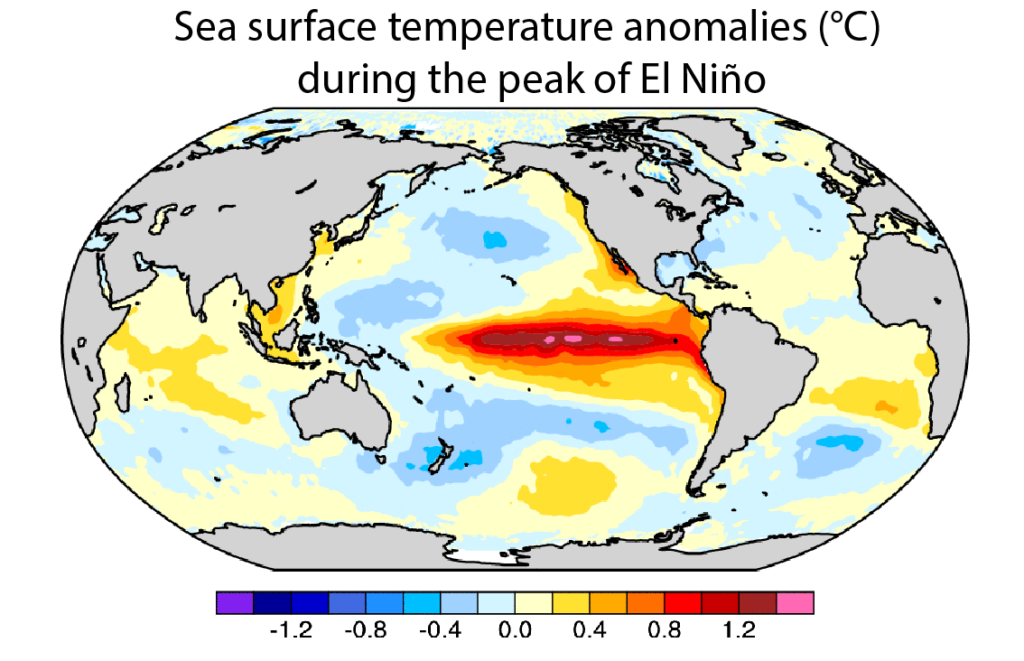
The final UTIG seminar of the Fall semester is reserved for graduate students to practice their presentations for AGU Fall. This year’s practice talks will be given by UTIG grad students Xian Wu, Kelly Olsen and Janaki Vamaraju. We asked each student to give us a sneak-preview into what they’ll be talking about and why they’re excited about sharing their research with the science community.
The seminar takes place at 10:30am (CST) on Friday, December 6 at UTIG. Click here to watch the seminar online.

Name: Xian Wu
Degree: Climate Dynamics PhD
Funding: Graduate Research Assistantship (currently), UTIG Graduate Fellowship (Spring 2020)
Expected graduation: 2020
Hi Xian. I hear you’re giving a presentation at this week’s UTIG seminar. What’s your talk about?
It’s about predictions of El Niño duration.
El Niño? Is this about why some years it rains more than others?
El Niño is the warm phase of an ocean-atmosphere phenomenon called the El Niño Southern Oscillation, or ENSO. La Nina is opposite to El Nino, the cold phase. This happens in the equatorial Pacific but has an impact on global weather patterns. El Niño and La Niña occur in the equatorial Pacific every 3-7 years. Sometimes they last for one year, sometimes two or longer.
Why does it matter how long they last?
Because both El Niño and La Niña come with climate impacts that persist for longer with long lasting events. For example, a multiyear La Niña might cause back-to-back droughts in the southern United States, including Texas.
That sounds serious! Do you know when the next long lasting El Niño or La Niña will happen?
Not yet! My first paper, which I published this year, looked into what controls the duration of both El Niño and La Niña. We found that early onset El Niño events tend to terminate after one year, whereas late starting El Nino events tend to last two years. Long-lasting La Nina events usually follow strong El Nino events.
How did you find that out?
These findings were based on statistical analyses of observations and climate model simulations that reproduce observed features of El Niño and La Niña. For this talk, I will be presenting an idealized forecast study. I will choose several El Niño events from a 1,800 year control simulation of the climate model and try to predict their duration. To do that, I take each El Niño event and run it through the model again thirty times, each time adding little butterfly effects into the atmosphere to mimic the unpredictability of nature. The predictable part is the ocean’s initial condition, which we estimate by looking at the average of the thirty forecasts. Then we compare this with what happened in the control simulation. So it’s kind of like using the model to predict itself.
That seems clever, but how can you be sure the models are correct?
The next stage of my research will be real world predictions. So for real world predictions, we give the model information from observations and see if the model we used for the idealized study can predict what we know has happened in the past sixty years. If it does, then we can be more confident about what it tells us will happen in the future. I actually just received a Spring 2020 UTIG Graduate Fellowship to study this!
Congratulations for the fellowship! So, this is your first UTIG seminar talk. How do you feel about giving such a prestigious and highly regarded talk?
I feel very excited. I hope I can do a good job! I actually gave two talks before at AMS (the American Meteorological Society’s annual meeting). The people who come to AMS are climate scientists and students, so those talks were for people from my field. Giving a talk at UTIG is challenging for me because I need to get my points across to a general audience who might not have a background in climate science. It’s a good opportunity especially for students and it’s also a good opportunity to promote our research!
Xian’s first paper was published earlier this year in the Journal of Climate. Her findings are a step towards predicting long lasting El Nino and La Nina.
Xian’s UTIG Seminar talk, which she will also present at AGU Fall 2019, is titled “Predictability of El Niño Duration Based on the Onset Timing”.
Good luck with both talks, Xian!
